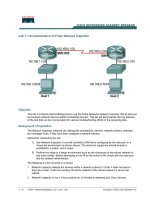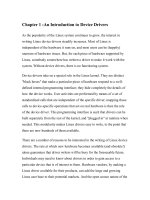1 fundamentals introduction
Bạn đang xem bản rút gọn của tài liệu. Xem và tải ngay bản đầy đủ của tài liệu tại đây (2.74 MB, 37 trang )
Crust to Core workshop:
An introduction to Perple_X
Sevilla, March 2009
Mark Caddick
Institute of Mineralogy and Petrology
Crust to Core workshop:
An introduction to Perple_X
Part 1: A very brief introduction
American Oxford Dictionary
Thermodynamics: the branch of physical science
that deals with the relations between heat and other
forms of energy (such as mechanical, electrical, or
chemical energy), and, by extension, of
the
relationships and interconvertibility of all forms of
energy.
Capabilities
Capabilities
Caddick & Thompson, 2008
Capabilities
• Construction of simple PT plots
relevant to metamorphic rocks
• Construction of complex PT plots
relevant to metamorphic rocks
• Calculating proportions and
compositions of minerals as a
function of PT
Capabilities
• Construction of simple PT plots
relevant to metamorphic rocks
• Construction of complex PT plots
relevant to metamorphic rocks
• Calculating proportions and
compositions of minerals as a
function of PT
• Understanding how rock
composition modifies stable
assemblage and mineral
compositions
Capabilities
• Construction of simple PT plots
relevant to metamorphic rocks
• Construction of complex PT plots
relevant to metamorphic rocks
• Calculating proportions and
compositions of minerals as a function
of PT
• Understanding how rock composition
changes stable assemblage and
mineral compositions
• Application of these calculations…
• PT evolution in continental collision
• Granite generation during orogenesis
• H2O/CO2 in metamorphism
Capabilities
• Construction of simple PT plots
relevant to metamorphic rocks
• Construction of complex PT plots
relevant to metamorphic rocks
• Calculating proportions and
compositions of minerals as a function
of PT
• Understanding how rock composition
changes stable assemblage and
mineral compositions
• Application of these calculations…
• PT evolution in continental collision
• Granite generation in the orogenesis
• H2O/CO2 in metamorphism
• Mantle mineralogy and melting
Capabilities
• Construction of simple PT plots
relevant to metamorphic rocks
• Construction of complex PT plots
relevant to metamorphic rocks
• Calculating proportions and
compositions of minerals as a function
of PT
• Understanding how rock composition
changes stable assemblage and
mineral compositions
• Application of these calculations…
• PT evolution in continental collision
• Granite generation in the orogenesis
• H2O/CO2 in orogenesis
• Mantle mineralogy and melting
• Fluid production during subduction, predicting seismic properties, thermodynamic data from
experiments, etc, etc..
Boundary conditions & assumptions
1. Garnet can be modelled in 1D:
Implying a spherical crystal geometry, sectioned through its centre
2. Modal proportion & composition of phases are defined by phase
equilibria constraints:
No
reaction overstep
instantaneous
is
(currently)
permitted,
rim
equilibration
is
3. Bulk-rock composition can be fixed or progressively depleted upon
Postulated P-T-t history of the Lesser
crystal growth
Himalaya, western India. After
Caddick et al. (2007).
4. Fe, Mg, Mn and Ca diffusion data after Carlson (2006):
Diffusivities are composition (position in model space) and P,T ‘’’’’’’’’’’’’’’’
5. The PT(t) path and fO2 conditions are prescribed:
Following example is based upon a Lesser Himalayan PT path
8
Goldschmidt 2008, Vancouver
Molefraction, X
Molefraction, X
Lesser Himalayan simulation - 1mm crystal
Distance, µm
No diffusion
Distance, µm
20 Myr path
with diffusion
Red = Fe: Blue = Mg: Black = Mn: Green = Ca
9
Goldschmidt 2008, Vancouver
Molefraction, X
Molefraction, X
Lesser Himalayan simulation - 1mm crystal
Distance, µm
No diffusion
Distance, µm
20 Myr path
with diffusion
Red = Fe: Blue = Mg: Black = Mn: Green = Ca
9
Goldschmidt 2008, Vancouver
Higher Ca
than Fe in
core
High-Mn
core
Molefraction, X
Molefraction, X
Lesser Himalayan simulation - 1mm crystal
Small compositional
‘steps’
Distance, µm
No diffusion
Distance, µm
20 Myr path
with diffusion
Red = Fe: Blue = Mg: Black = Mn: Green = Ca
9
Goldschmidt 2008, Vancouver
Molefraction, X
Molefraction, X
Lesser Himalayan simulation - 1mm crystal
Distance, µm
No diffusion
Distance, µm
20 Myr path
with diffusion
Red = Fe: Blue = Mg: Black = Mn: Green = Ca
10
Goldschmidt 2008, Vancouver
A very quick introduction to (or some revision on)
thermodynamics
An introduction to (or some revision on) thermodynamics
American
Oxford
Dictionary
The first law of thermodynamics states the equivalence of heat
and work and reaffirms the principle of conservation of energy.
The second law states that heat does not of itself pass from a
cooler to a hotter body. Another, equivalent, formulation of the
second law is that the entropy of a closed system can only
increase. The third law (also called Nernst's heat theorem)
states that it is impossible to reduce the temperature of a
system to absolute zero in a finite number of operations.
An introduction to (or some revision on) thermodynamics:
Some definitions
•
•
A system is some part of the universe that you want to study and understand
The surroundings are everything else in the universe that is not in our system
The system can be open or closed to (isolated from) the surroundings in terms of
both matter and energy
All Changes in a system are associated with the transfer
of energy
Natural systems tend toward states of
minimum energy
An introduction to (or some revision on) thermodynamics:
Some definitions
• In our case, a system is likely to be a mineral or a rock
• In this case, it is comprised of chemical components that
describe chemical variability in that mineral or a rock
• Typical components might be FeO, MgO and SiO2 used to
describe olivine
• A phase is any mechanically separable and chemically
homogenous portion of the system, e.g. a melt, a fluid, or a
mineral in a rock
• A reaction is anything that changes the nature of the
phases within a system
An introduction to (or some revision on) thermodynamics:
Some definitions
• Thermodynamics is primarily concerned with macroscopic
energies of microscopic processes that we might or might not
fully understand.
• It is convenient to group all of the variables required into two
classes:
Intensive variables are independent of the amount of
material present:
e.g. Pressure (P) & Temperature (T)
Extensive variables are dependent on the amount of
material present:
e.g. Volume (V) & Entropy (S)
An introduction to (or some revision on) thermodynamics
First Law of thermodynamics:
The increase in the internal energy (U) of a thermodynamic
system is equal to the amount of heat energy (Q) added to the
system plus the work (W) done on the system by the
surroundings.
dU = dQ ± dW
An introduction to (or some revision on) thermodynamics
First Law of thermodynamics:
The increase in the internal energy (U) of a thermodynamic
system is equal to the amount of heat energy (Q) added to the
system plus the work (W) done on the system by the
surroundings.
0 = dQ + dW - dU
W (J) = N•m = P •V (P = force/area [N/m2] and V = m3)
dU = dQ + PdV
An introduction to (or some revision on) thermodynamics
Second Law of thermodynamics:
This introduces the notion of entropy (S) which relates change in
temperature (T) with the heat energy (Q) added to the system:
δΘ
dS ≥
Τ
Which can be substituted into the first law:
dU ≤ ΤδΣ − Πδς
An introduction to (or some revision on) thermodynamics
dU ≤ TdS - PdV tells us about the energetics of a system without
chemical change (i.e. a homogenous phase with no
compositional change during the process).
To describe energetic changes coming from mass transfer we
use the concept of chemical potential (Gibbs, 1876)
⎛ ∂U ⎞
µi ≡ ⎜ ⎟
⎝ ∂n ⎠
i
S, V , other components
An introduction to (or some revision on) thermodynamics
dU ≤ TdS - PdV tells us about the energetics of a system without
chemical change (i.e. a homogenous phase with no
compositional change during the process).
To describe energetic changes coming from mass transfer we
use the concept of chemical potential (Gibbs, 1876)
⎛ ∂U ⎞
µi ≡ ⎜ ⎟
⎝ ∂n ⎠
i
S, V , other components
Summing the energies associated with all components in the
system and adding to our combined laws equation yields
dU = ΤδΣ − Πδς + ∑ ι −1 µιδνι
κ
An introduction to (or some revision on) thermodynamics
dU = ΤδΣ − Πδς + ∑ ι −1 µιδνι
κ
Is the fundamental equation that we will use to quantify internal
energy. This can be transformed to give various combinations of
S, V, T and P as the independent variables.
Gibbs free energy: dG = − ΣδΤ + ς δΠ + ∑ ι −1 µιδνι
κ
Gibbs free energy will be of most interest to us, since P and T
are the most obvious choices of independent variables for
geologic application









